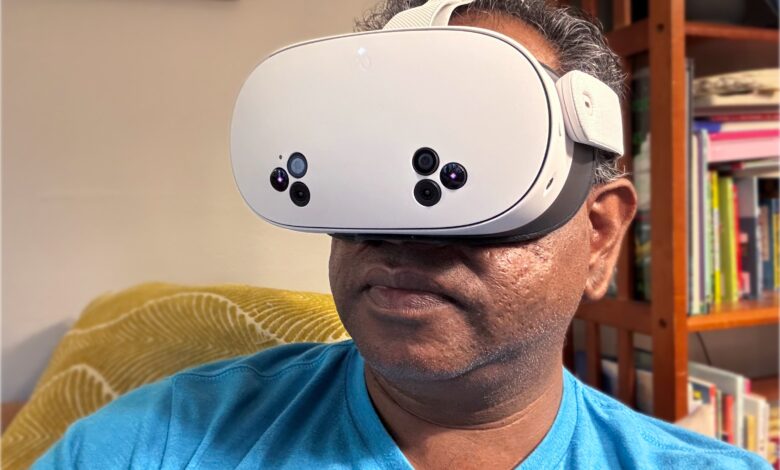Meta Quest 3S hands-on: A $300 VR headset without major compromises

Instead of cramming more technology into its Quest VR headsets, which would inevitably escalate their price, Meta has taken the opposite approach with the Quest 3S. It’s a slightly bulkier, slightly less sharp version of the Quest 3 starting at $300, almost half off that headset’s $500 launch price. The Quest 3S pitch is clear for consumers and developers alike: It’s a more powerful and feature-rich budget device than the now defunct Quest 2, and since it has the same processor and GPU as the Quest 3, developers don’t have to worry as much about supporting older headsets either.
Based on my brief hands-on time with the Quest 3S (our full review is in the works), it’s easy to see how this could be another hit for Meta. Despite its lower price, it doesn’t look or feel inferior to the Quest 3 at first. The only noticeable external difference is that it uses a triangular array of sensors up front, instead of three pill-shaped modules. While it’s a bit larger than the Quest 3, it still sits comfortably on my face, and is easily adjustable via its rear and top straps.
I winced when I noticed it no longer had a 3.5mm jack, leaving you to use wireless headphones or a USB-C dongle instead, but its absence makes sense for a cheaper product. I’d wager the people who care most about a headphone jack would also opt for the Quest 3, instead.
Meta cut corners all over the place to drive the Quest 3S’s price down. There are only three lens adjustment positions to match your pupillary distance, whereas the Quest 3 has finer controls. And instead of pancake lenses, the Quest 3S uses Fresnel lenses which can lead to additional glare or other artifacts. Those also pair together with lower quality displays, which offer 1,832 by 1,920 pixels per eye (like the Quest 2), instead of the Quest 3’s 2,064 by 2,208 resolution.
What’s more important for consumers is what Meta does include in the Quest 3S. It sports the same Qualcomm Snapdragon XR2 Gen 2 processor and 8GB of RAM, and uses the same updated touch controllers. So while the Quest 3S might look a bit fuzzier than the Quest 3, it should perform the same.
That’s something I immediately noticed upon booting up the Quest 3S. Navigating its main menu and the Quest store felt effortless and snappy, with little lag between screens or apps loading. The touch controllers still feel very responsive, too, something I confirmed with a few Beat Saber sessions. While it does get a bit warm, like its pricier sibling, the Quest 3S trucked along without any noticeable slowdown while I was installing several large games. The mixed reality experience was also similar to that on the Quest 3 — it’s far from lifelike, but it’s clear enough to read text on your monitor or phone in a pinch.
Based on a few hours of testing, the Quest 3S clearly manages to deliver an immersive VR experience at a lower price point. But we’ll have to spend a bit more time in virtual reality to determine how, exactly, it differs from the Quest 3.
This article originally appeared on Engadget at https://www.engadget.com/ar-vr/meta-quest-3s-hands-on-a-300-vr-headset-without-major-compromises-133012786.html?src=rss


